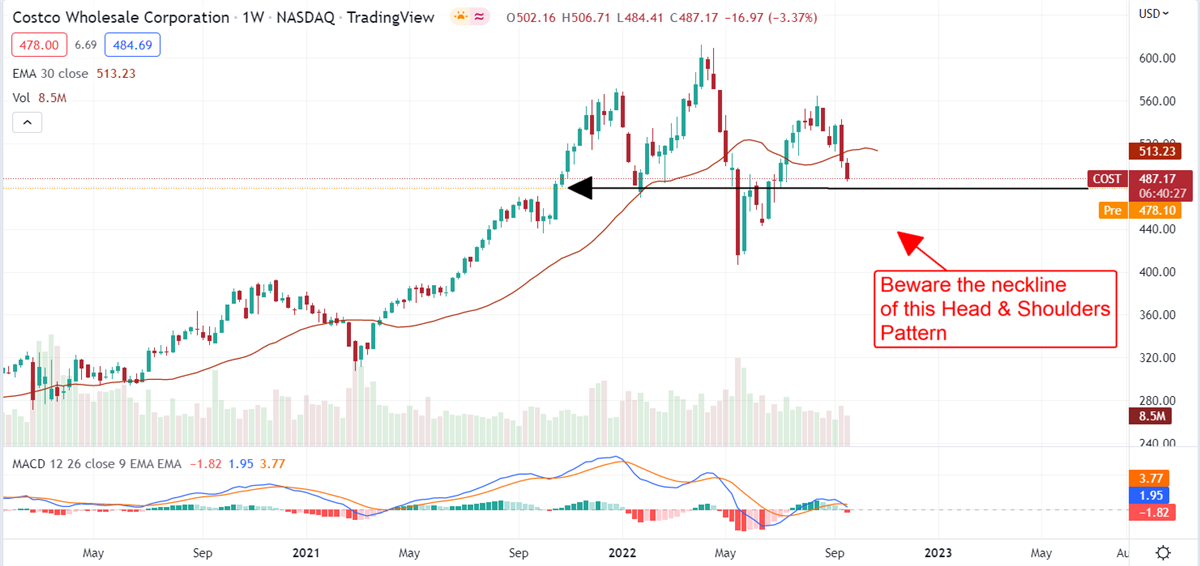Costco (NYSE: COST) put in a strong quarter, but there are two things wrong with the report that means the strength was already priced into the market. The first is a similar report from BJ’s Wholesale Club (NYSE: BJ) last month, a report that indicated strength in the membership club arena as shoppers seek out bargains. What this means for Costco is a pullback in share prices that could set the market up for another great buying opportunity. The question is if support buying will kick in sooner or later, and there is a risk the stock could fall down to the $400 level or lower. Trading at 37X its earnings outlook, the stock is pricey compared to the broad market S&P 500 (NYSEARCA: SPY) and its peers, and this could present a problem in the near term. BJ’s Wholesale Club and Walmart (NYSE: WMT), parent of Sam’s Club, trade closer to 22X their earnings, which provides quite a discount relative to Costco.
Costco Moves Lower On Strong Q4 Results
Costco had a great quarter and brought in $72.09 billion in revenue for a gain of 15% versus last year, but it only beat the consensus figure by a slim 0.1% which is not saying much. The growth is also a deceleration from the previous quarter and prior year but only by 100 basis points or so, making this the 5th consecutive quarter of revenue growth in the range of 15% to 18%. The gains were driven by a 10.4% system-wide comp store gain that was amplified by a higher store count. Growth was strongest in the US, with a gain of 15.8% or 9.6% on an X-fuel basis which is better than the 9.3% Marketbeat.com consensus figure. eCommerce, a pillar of the company’s growth strategy, is up 7.1%.
The margin is the second thing wrong with the report. The company produced a solid margin for the quarter and the year, but the $4.20 in GAAP EPS is only as expected. In light of the slim margin of topline outperformance, this result is weaker than it should be, if only slightly. The takeaway here is that market expectations were not met, there is some evidence of margin contraction, and that is weighing on share prices. The company did not give any formal guidance, but it can be expected to grow comps and open new stores in the coming year. The question is how strong the growth will be, and it is likely to slow simply due to the law of large numbers, if nothing else.
Costco may raise its membership fees to help boost its top and bottom line performance, but it would have to be a significant increase to truly move the needle. The company reported $4.22 billion in membership fees for the past year, which amounts to about 1.85% of the company’s revenue. A 10% increase in membership fees would only increase the net by 20 basis points which is not much at all. The risk, however, is that Sam’s Club membership is less and may lead customers away from Costco in territories they overlap.
The Technical Outlook: Costco May Enter Reversal
Shares of Costco have traced out a nice looking Head & Shoulders Reversal Pattern over the last nine months or so and have only to confirm the pattern to enter a deeper decline. The pattern’s neckline is near the $470 level, and that is very close to where the premarket action has the price of Costco. A move below that level would confirm the pattern and could lead the market down to the $380 level or lower. If, however, the market puts in a solid bottom at the $470 level, investors should expect Costco to continue moving sideways and eventually resume its uptrend and retest the $600 level.

Before you consider Costco Wholesale, you'll want to hear this.
MarketBeat keeps track of Wall Street's top-rated and best performing research analysts and the stocks they recommend to their clients on a daily basis. MarketBeat has identified the five stocks that top analysts are quietly whispering to their clients to buy now before the broader market catches on... and Costco Wholesale wasn't on the list.
While Costco Wholesale currently has a Moderate Buy rating among analysts, top-rated analysts believe these five stocks are better buys.
View The Five Stocks Here
Looking to profit from the electric vehicle mega-trend? Enter your email address and we'll send you our list of which EV stocks show the most long-term potential.
Get This Free Report
Like this article? Share it with a colleague.
Link copied to clipboard.